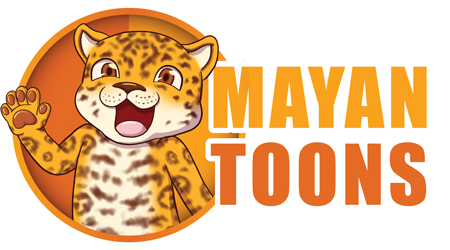Personal experience with chocolate and cacao trees, in Mexico and Guatemala
We will have cacao characters in our Maya comic book cartoons, grandparents, females, kids: entire family of plant cartoon characters. This page is to introduce our background in learning about cacao. Anyone can draw a bird, animal, or plant cartoon: we differ because we have personal experience in both the natural eco-systems of these species, and with the plants, animals, and insects themselves.
Visiting cacao plantations in Soconusco (in the Chiapas portion)
Often I would lead tour groups to the pre-Mayan ruins of Izapa, between Tapachula (Chiapas, Mexico) and the Guatemalan frontier. This entire area is covered with cacao plantations. So I got plenty of exposure to cacao trees in the heart of the cacao-growing area of the Aztec empire.
Visiting cacao plantations in Tabasco, Mexico
I held three post-graduate research positions at Yale University, starting with a OEA fellowship to work with Prof. George Kubler in the Dept of History of Art. It was decades ago, but I remember this was extended by the university as a basic fellowship to allow me office space at Yale. So I lived in New Haven for several years (though spending much of this time in Mexico, Belize, Guatemala, and Honduras lecturing for tour groups; that was what enabled me to visit so many Puuc, Chenes, and Rio Bec sites in Mexico).
Then Dr Michael Coe provided a fellowship or assistant curatorship at the Peabody Museum of Natural History. During this time I also maintained scholarly contact with the Dept of History of Art, via Dr Mary Miller.
Professor Michael Coe was the brother of Dr William Coe (University of Pennsylvania) who was the Project Director of the Tikal Project in Guatemala. So I had the opportunity to work under, and learn from, both of these learned scholars. Their personalities were about as different as night and day. And each had a different part of the Maya culture that they specialized in.
At one point Dr Michael Coe indicated he would appreciate some photographs of cacao for the book he was finishing after his wife unfortunately passed away with cancer. This book was published in 1996. To obtain the photographs that I felt would look nice in his book I drove from USA to Tabasco with a vehicle filled with my portable studio, Leica and Nikon and Hasselblad cameras. My resulting photographs are nicely credited in The True History of Chocolate.
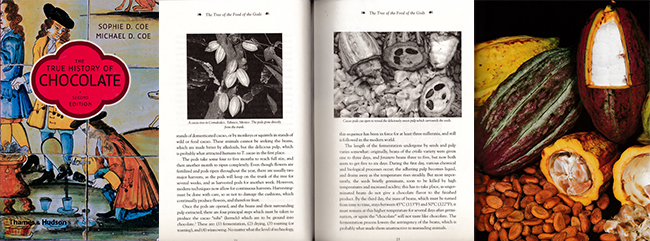
I also did photography of cacao of Tabasco for the book on cacao of Dr. Yoshiho Yasugi, Minpaku (The National Museum of Ethnology, outside Osaka, Japan).
Cacao in Copan Ruinas village, Honduras
Although the climate and altitude of Copan Ruinas are different than lowland Tabasco and lowland Soconusco and areas of Guatemala where cacao is popular, there are plenty of healthy fruiting cacao trees in this Honduran village, both in at least one of the hotels, and also in the inside patio of the village archaeology museum.
I was first at Copan Ruinas as a typical backpacker tourist, at age 17 or 18. I went in and out seated on sacks of maize in the back of a giant cargo truck (since in these years, the 1960’s, there was no regular bus service from this part of Guatemala).
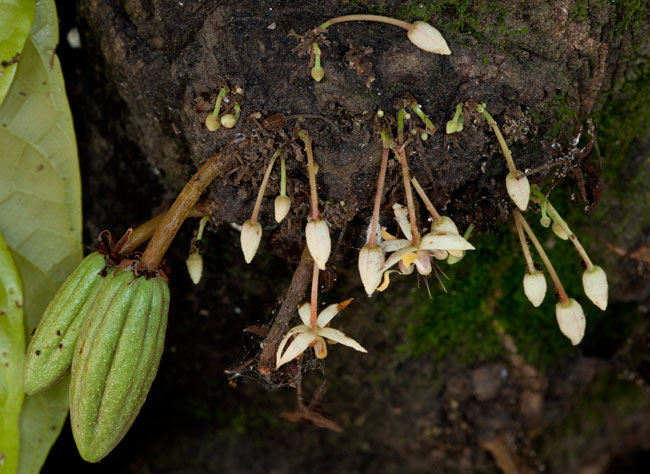
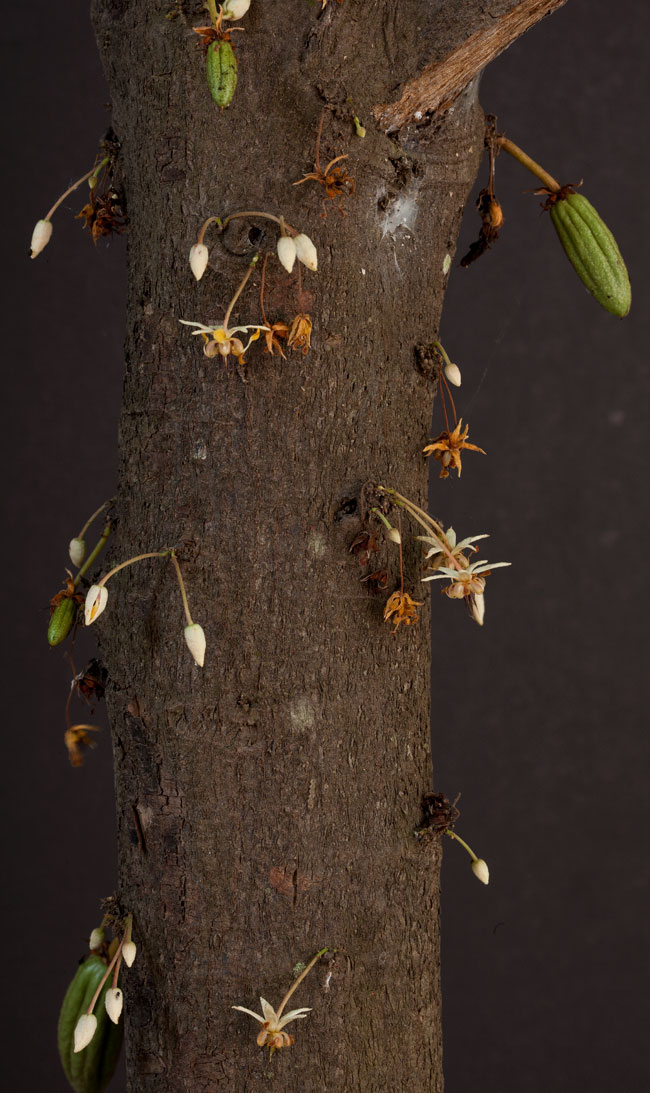
First experience with Maya cacao was in 1965, at age 19
My first experience with chocolate was at age 19, deep under a royal pyramid at Tikal. He was a student intern at Tikal, taking a year away from Harvard, to work for the University of Pennsylvania project at Tikal.
One of the larger vases in this richly stocked royal burial crypt had once been a liquid. The liquid had dried, and solidified into a structure mixed with a lot of bean-shaped seeds (which were mostly hollow).
At age 19 I had never seen a cacao bean, so I estimated these were some kind of frijol (like the black beans you see in so many restaurants in remote parts of Guatemala). But now that I know what a cacao bean looks like I realize the size and shape of the beans in this vase were cacao size, not frijol sized!
This material was put by me into a plastic bag or appropriate lab container and brought to the Tikal camp lab building. Whether it survived long enough to be analyzed I would doubt it. Too bad, as would be nice to know whether it was cacao or pataxte, and what flavorings were in the liquid around it.
About seven years ago I began growing my own cacao
I grow cacao around the FLAAR office. We have planted pataxte but it wants much more sunlight and warmer weather. Remarkably Theobroma cacao is more adept at adapting than is pataxte. Plus Theobroma cacao grows faster.
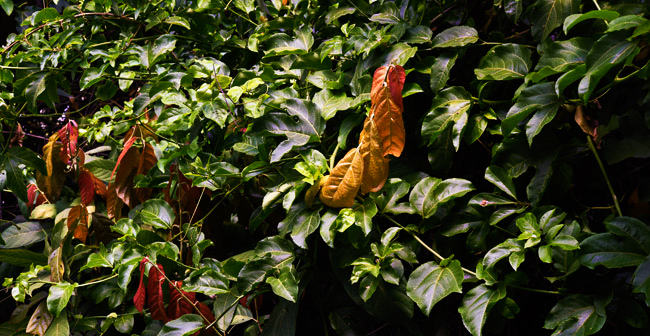
I learned a lot about what parts of my garden made the cacao trees the happiest: deep inside a tiny 3 x 3 meter interior patio, with the office walls shielding the tree from sun most of the day, and vines shielding the tree from the sun the rest of the day! But the leaves always work hard to grow above the vines to soak up a tad of sunlight.
This tree flowers about every 2 or 3 years (remember, at elevation of 1500 METERS), it is far outside its favored eco-systems). It rarely fruits because wind knocks off the fragile flowers.
But trees up on top of the roof have indeed fruited and they grew quite large. But normally the lack of humidity (and high wind) results in the pods not reaching maturity. Plus the cacao on the roof are in pots, not in the ground. So it is remarkable that they flowered, and fruited (I highly doubt there are midges here to pollinate them…., so clearly these can be self-pollinated).
But although I am not a botanist, my experience here disproves several statements in textbooks and peer-reviewed journals (since not all authors actually grow cacao around their home or office!).
Recently I was off searching for Theobroma angustifolium
Not much information is available on how, when, and why Theobroma angustifolium arrived in Guatemala and adjacent Mexico. 90% of books and peer-reviewed journal articles on cacao of the Olmec, Maya, and Aztec simply do not mention Theobroma angustifolium: they only mention cacao and pataxte.
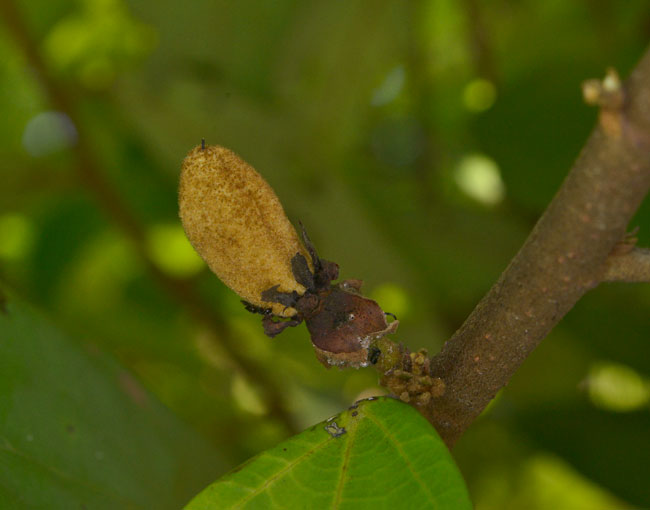
100 years ago Theobroma angustifolium was widely grown. Today I would be surprised to find any trees of this in Alta Verapaz (Guatemala). We have found two lonely Theobroma angustifolium trees in the Costa Sur (precisely where it filled entire plantations 100, 200, ??? years ago). The reason it is no longer grown is because every other species and variety produces more pods (and more pods that last until you can harvest them).
Most of my work on cacao the last five years has been on the flavorings
While communicating with Dr Michael Coe about five or so years ago, he suggested that the area of cacao research which was most in need of fresh initiative was to study and learn about (and write about) the flavorings for cacao. His comments inspired me to dedicate myself and my support team to first spend several years researching and learning what plants were flavorings, and then three years to go out into the deserts, swamps, forests, and fields of Guatemala (and Honduras and El Salvador) to find, and photograph when flowering, each seasoning plant.
FLAAR now has the largest high-resolution digital photograph archive in the world on all the plants used to flavor cacao (and the plants which were added to cacao beverages with cacao merely as the vehicle for ingesting the special ingredients).
We hope a university or museum will be interested to acquire this photo archive, as dozens of theses and dissertations (plus coffee table books) could be handsomely illustrated with these remarkable photographs in remote areas of Mesoamerica.
First posted April 7, 2016
